- info@wildlife-removal.com
Call us for help in your town
Wildlife Removal Education
How to Trap a Rat - Rodent Trapping
Need bat removal in your hometown? We service over 500 USA locations! Click here to hire us in your town and check prices - updated for year 2020.
As stated, the first step toward successful rat trapping is to seal up all entry points into a house. Only then should you bother to even start trapping - if you don't seal up the holes, new rats will
just keep coming. If you need help with a rat infestation, click on this map of Professional Rat Removal Companies serving every town/city in the USA.
I have done maybe 1200 rat control jobs in my life, over many years. I have tested many methods, and changed my approach many times. During my first year and first 50 jobs as a rat removal company,
I had a lot of problems, and had to keep working on it. But I was persistent and experimented a lot, and I believe I have come up with the very best systems to trap rats. My current success rate is
always 100% - I solve the rat problem permanently within days. So I know I have it right now. How much does rat control cost? Get rat extermination prices.
FIRST STEP - Of course, as stated, rodent trapping is pointless unless you know you've blocked off all the entry points into the home. If not, new rats will just keep coming in, and you'll have to
keep rat trapping forever. And also, once you've sealed off the holes, there are a few rats stuck inside, and they suddenly become EASY to trap. Get them, and the job is over in a few days.
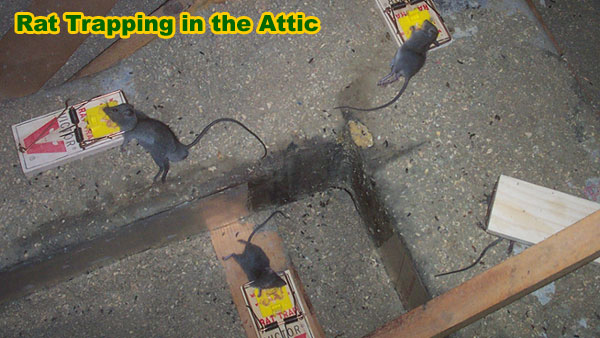
SECOND STEP - Set snap traps. In fact, I'm going to recommend a brand. The original wooden Victor snap traps. I have tested about ten different snap traps thus far, and many are of clever design, but
absolutely none work better than this model. You can set it at a very sensitive level, on many different surfaces. Now, here's the key -
LOCATION IS EVERYTHING. Some lazy rat trapping companies
just put a few traps around the attic hatch door. That won't cut it. You've got to inspect the whole attic, and find out where the rats are running. The run the same paths over and over and over.
These paths are easy to see - they are covered in rat droppings and brown grease, and they are trampled down. Just set the traps right across these rat runways. And how many rat traps should you set? I
always set at least a dozen. The more the better success you will have. What about rodent bait? You don't even need to bait the traps.
I'm telling you, bait does not matter. But if you must use bait, peanut butter is great. Some people use Slim Jims, chocolate, etc. But what bait do you use to trap a rat does not actually matter nearly
as much as the location of the trap.
THIRD STEP - Monitor the traps, remove all dead rats from the traps and reset. You ought to check the traps every day or every couple of days, before the rats start to decompose and stink. Once you stop
catching rats, and once you stop hearing them running and scratching and scampering in the attic and walls, you know the problem is solved for good.
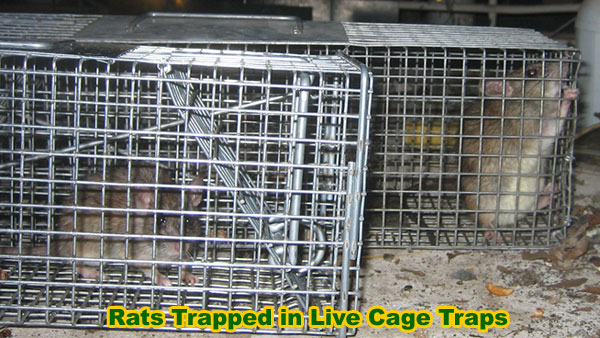
Can you use a humane live cage trap? Of course you can! I've done so many times to make customers happy! But unfortunately, here's the deal. Rats are incredible creatures of habit. They are very attuned
to their environment. You may not believe it, because I was very surprised when I first read it, but it's true: the rats that live in your home and attic occupy an extremely small territory. They will rarely
venture more than 100 feet from their nest. They don't roam around the neighborhood. If they can't find what they need in a small space, they don't survive. Rats that have to travel around get killed by
predators. Rats that venture into another rat's territory get killed. A rat that does not have its home nest will definitely die within 48 hours. So the problem with a live cage trap is that if you catch a
rat alive and relocate it somewhere outside, it's toast anyway. So why not quickly and humanely kill it? Oh, and live traps are simply less effective. And if you don't check them at least twice a day, the
rats trapped inside will die of stress exhaustion. And as stated, you ought to set a dozen traps - do you have a dozen cage traps? Can they fit into the tight gaps that rats live in?
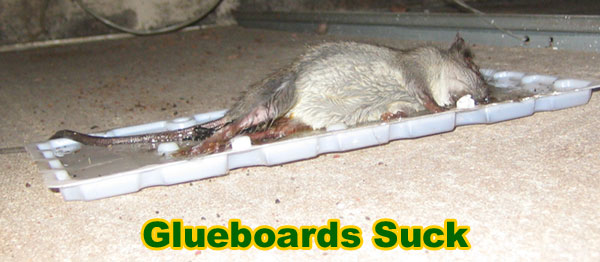
Finally, I'll quickly address glue board traps. There is no reason to use this type of trap. It offers no advantage over a snap trap. I've been to many houses where the customer or a prior pest control company
has set glue boards, and I see a lot of rat footprints, rat fur, even chewed-off rat limbs. So they don't always work. And they are BY FAR the least humane of any trap. And they are not reusable. So take that into consideration.
Rat removal info - main rat removal information page.
How are rats getting in - this is what you need to read if you want to solve the problem.
Rat repellent - do repellents and rodent deterrents work?
How to get rid of rats - just another general guide.
Rat in building - general information on different parts of buildings rats get into.
Rat damage photos - just so you know what they are capable of, and so you can see the signs.
Pest control for rats - why to never hire a regular pest control company to do rat work.
How to kill a rat - another guide, helping to humanely solve the problem.
Rat prevention - some tips to keep rats away, and lessen the number in the area.
Rats in the attic - a good guide to one of the most common problem areas with rats.
Photos of rat poop - for identification purposes.
I will now address some of the more common questions that I receive about rats getting into a building:
How to trap a rat in the attic - set snap traps on the common areas rats run - the trails with rat droppings and trampled insulation.
How to trap a rat in the basement - set the traps along the edges, along the walls, and everywhere you see rodent feces.
How to trap a rat in the building - best trapping methods are where the rats frequently go - there's no point in setting where rats never run.
How to trap a rat in the ceiling - if it's a drop ceiling, remove the panels. That's a great spot. If not, you've got to go into the attic and set there. In between floors is inaccessible, so you have to find another spot where you can reach and
set snap traps.
How to trap a rat in the garage - set the traps along the edges, along the walls, and everywhere you see rodent feces. The entry holes are great too, such as the corners of the garage door.
How to trap a rat in the garden - it's dangerous to set snap traps outside, so a cage trap or a trap locked in a Protecta box is the best bet.
How to trap a rat in the house or home - if it's in the house, you'll probably want to set the traps in areas that are safe, such as behind the furniture, behind the oven, or in the cabinets in the kitchen. Be sure to be careful!
We now service over 500 locations! Click here to hire us for wildlife removal in your town.
Rat Trapping Tips: Getting your house back to rat-free after an infestation can be quite the task. One method with a good track record at achieving this is the use of traps and baits. There are basically four types of traps that can be used to control rats and they are: Snap traps, Glue traps, Poison traps and live traps.
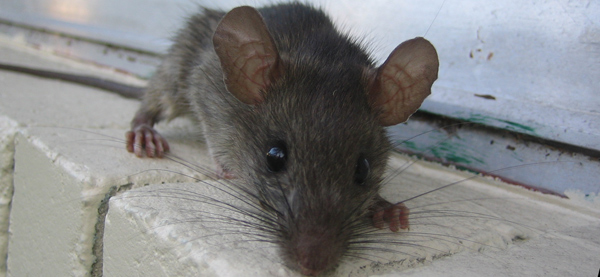
Snap Traps
When a rat lured by the bait sets off the trigger of a snap trap, a wire snaps across the neck of the rat killing it instantly. The trick is to get a big enough snap trap so that once the wire snaps, it kills the rat. A small snap trap might just injure but not kill the rat. The good thing about snap traps is that they can be re-used but if you are too humane to watch a rat die this way, you should probably skip it because it involves blood and sometimes urine as the rat dies.
Glue Traps
Glue traps are pads that are covered with thick adhesive and a bait in the middle. The rat in wanting to get to the bait in the middle gets stuck on the glue and as it struggles to go free, its mouth gets stuck too leading it to suffocate and die. The bad thing about a glue trap is that it doesn't catch all rats and sometimes the rat doesn't die quickly enough, leaving you to kill it yourself. Also the adhesive dries out after a long period leaving it ineffective.
Poison Traps
Poison trap involves a pre-packaged poison that is kept at a spot frequently used by the rat(s). The bait will be coated with the poison so the rat eats the bait, unknowingly ingesting the poison and then goes off to die in some obscure place. The bad thing about this sort of trap is that you'd have to constantly worry about your little children and/or pets if you have any, stumbling on the trap. Another thing is, if this trap is indoors, the rat would probably die in an unknown place in the house and would begin to rot.
Live Traps
These kind of trap is usually in the form of small metal cages. A bit of poisoned bait is placed on a pressure-sensitive pad so that once the rat steps on the pad to take the bait, the trap door snaps shut trapping the rat in the cage. The cage must not have gaps in-between its steel mesh that measure up to a half inch because a small rat can squeeze through a space that small. This kind of trap is effective if you have only one rat in the house, unless you would have to empty the cage each time you need to catch another rat.
After live trapping a rat, you may transport it far away from your house and release it back into the environment; you may also turn it over to your local animal department if you would rather not kill it.
Baits
Baits are the food pieces that are used to lure rats into traps, and they are poisoned most of the time. The kind of bait to be used depends on the kind of rat that you want to get rid of. Black rats are vegetarians while brown rats eat plants, food and meat. Rats cannot vomit what they've eaten and so they are likely to eat the same bait over and over again. The best baits are the smelliest ones because they attract the rats more. Liquid bait is also very potent.
Here are some examples of effective baits:
Peanut butter – it is usually sticky and rats cannot sneak it out of the trap unlike cheese. The rat is compelled to stay and eat it, during which time the trap door or wire is triggered off.
Meat: Brown rats love meat but you have to use meat as bait with utmost caution, especially if you have domestic pets or little children around the house.
Fruits and vegetables are mostly attractive to black rats but the fruits have to be constantly changed since rats cannot eat rotten or spoiled fruits.
Other bait ideas include:
Cheese
Cereals
Cat food
Chocolate spread
Dog food
Yarn
Cotton balls
Go back to the Rat Removal page or the How to get rid of rats page.
Customer Rat Email: Hi, Those traps don't look humane, and you advertise yourself as humane, might wanna change that. Paula
My Response: What traps are you talking about? I use many types of traps for many different types of animals. All are humane, so please explain what trap you are looking at.
Customer: the rat traps, probably it's quick but I bet not all get just their heads in it and die quickly, some probably get a leg, or body or tail and have a slow painful death,
am I right? None of those pictures were on there. Your website is pretty gory, and seemed a bit too joyful for the horrible job
My Response: Oh, you were talking about snap traps for rats. I wasn't sure what animal or trap you were referring to. I usually use live cage traps for all animals, except for
rats. The thing is, if you live-catch rats in cages, or if you use one-way exclusion doors, they are going to meet a worse fate than a snap trap. I've studied this for a long time and I can't
find a better alternative. Also, when I set traps correctly on runways, the kill rate vs. the misfire rate is about 95%, I'm not kidding. But ANYTHING is WAY better than using poison.
Customer: ok, then I apologise, can we use your services in Roseville soon please? This is a distressing situation for us, we have a sweet pet rat, and I know wild rats aren't
like the pets, it's still tough. It's actually the house we used to live in and now rent out. We had cats who used to bring us rats/mice now and then, but apparently their house is infested now.
We do need help I liked your blog, thank you. Paula
What to Do About Rats I Can’t Trap?
A trap-shy rat is a rat that is shy of the trap you put own for it. That's pretty much as simple an explanation as you're going to get, and it's a more common phenomenon than you might think. Rats are a lot more intelligent than many of us would give them credit for, and alongside evolving to eat practically any food source in order to survive, rats have also learned how to stay out of trouble. This includes staying away from traps.
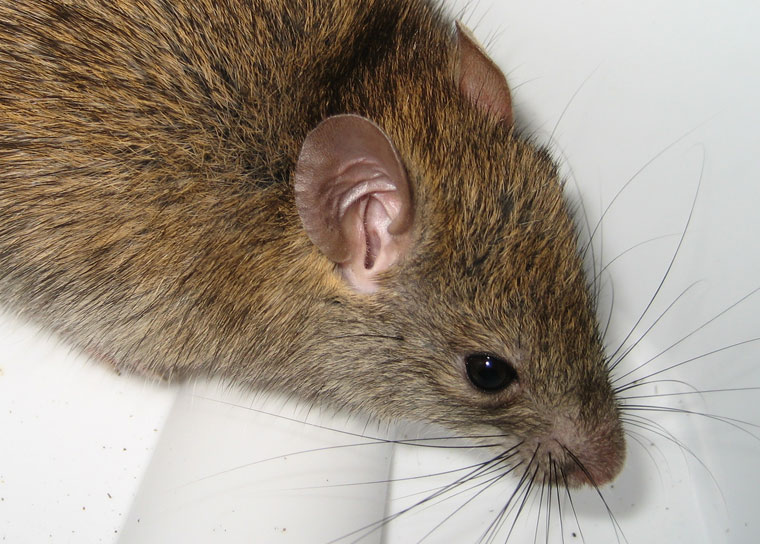
Why do rats become trap-shy?
Rats will learn about traps in a number of ways. One rat might see another rat from its social group fall prey to a snap trap. It might have tried to rescue another rat from a live cage trap. It might have learned the hard way too - being captured in a cage trap itself and then dumped back out in the wild, miles away from home and nowhere near the rest of its family and friends.
Rats are super social animals and don't tend to fend so well when removed from their social groups. It is not uncommon for the "humane" approach of trap-and-release to fail - rats often die within just a few days or weeks of being released into a new and unknown territory.
Trap and release methods for rats do not work because they either manage to find their way back home after you have released them, or they die in the wild. If they do manage to survive or find their way back home, they are now much smarter. They know how traps work and will now avoid them. Not only have you made your own job more difficult (if the rat comes back to your property), but you will have made other people's lives quite difficult by accident. If the rat moves into another residential or commercial property and the owner puts traps (live or kill) down, the rat will avoid them at all costs and live on quite happily.
What to do about rats I can't trap?
A trap that has had its bait removed without catching a rat, is likely to have been preyed upon by a rat that is trap-smart rather than trap-shy. You could try looking at the bait-type in this situation - it is too easy for the rat to remove it without setting off the trap. Try something sticker that the rat must work a little harder for, and you should have a little more luck.
If the bait isn't touched at all, it could be that your traps are not in the right places. If rats don't usually take a route that your trap has been placed along, the traps won't get touched and neither will the bait. Keep your eyes peeled for signs of rat activity - poop, chewed holes, urine stains, fur chunks or grease markings. Where you see these signs, the rats are hanging out. Those places are the best places to put your traps.
If you're putting traps in areas of high activity but still aren't having any luck, it might be time to take a slightly more patient approach. We know these aren't words that you want to hear, but taking your time and putting those traps own without setting them or baiting them can work in your favor.
The process is very simple For a few nights, put the traps where you would usually put them, but don't set them. Leave them un-baited and un-set.
Give it a few nights for the rats to become used to the new object in their surroundings. A few of them will be inquisitive, and their bravery and the fact that nothing happens when they go near the trap will make any trap-smart or shy rats much braver too.
After three or four nights, sometimes longer depending on the situation, start to add bait to the traps. You can use the next few nights to work out which bait seems to be the biggest hit among the group. You're not setting the traps to kill or capture the animals, but you are essentially putting food out for them. Once again, you want the rats to get used to the new object in their surroundings, but this time, with food on top.
Give it another couple of nights and then set the traps. Put them down, bait them, and set them to go off. You should find that the shy rats are a little less shy and your efforts will not have been in vain.
What Do You Need to Successfully Trap Rats
Trapping rats is getting harder these days, and this is because rats are learning. They're evolving. They're getting smarter. They're starting to learn that shiny, metal contraptions either mean being removed from their group and dumped somewhere scary and brand new, or they'll end up dead. If a rat were to see one of its own get snapped up by a trap, it would, quite rightly, be dubious about experiencing the same fate - lump of cheese as bait or no lump of cheese!
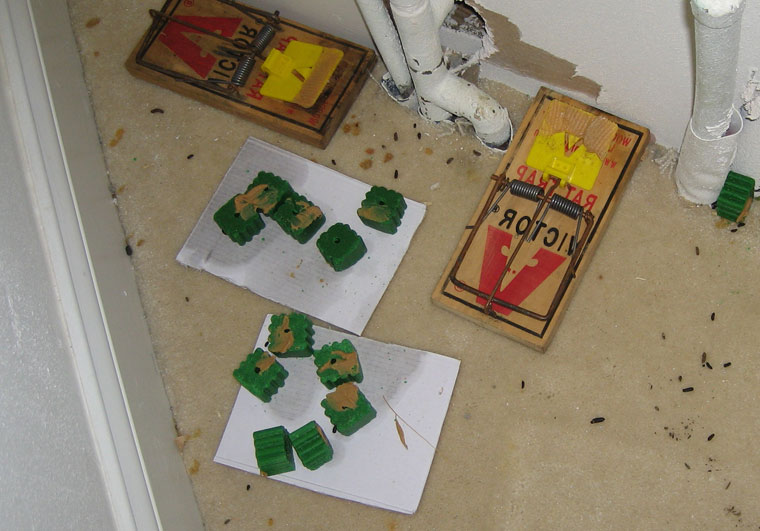
Successfully trapping rats is best done when you use the right kind of trap - snap traps. These are traps that kill the rat immediately. If you attempt to use live cage traps, not only will you spend a great deal of your time driving miles away to release yet another rat, but you'll also smarten them up too. A trap-shy rat is one that has already experienced being trapped and released (we assume) and is now smart enough to avoid traps altogether. Even kill traps.
With each unsuccessful approach to rat removal that you attempt to use, the rats get a little more knowledge. They'll learn that water makes them wet when erupting from a sprinkler, but it doesn't harm them and doesn't give them any reason to move along. They'll learn that hot and spicy foods don't taste or smell great, but they're usually only confined to one areas, so moving away just a few feet from that area will soon relieve the problem. In fact, this is often the case with many smell or taste-based repellents for rats.
When you trap and then release a rat, you are teaching that animal to avoid traps. When you then come face to face with that same rat in your home, getting rid of it with snap traps will be even more difficult. We like to think these creatures are stupid, but they're not. They're far from stupid. They're evolving quicker than we are it would seem.
What Do You Need to Successfully Trap Rats
KNOWLEDGE.
You'll need a few physical items, of course, but the biggest thing you'll need to get rid of rats is knowledge, and lots of it.
You'll need to know the size of hole a rat can squeeze through. (It's 1/2 - 3/4 inch.)
You'll need to know where rats like to hang out in their rat pack. (Dark, quiet and damp areas, such as attics or wall cavities.)
You'll need to know what is attracting them to your property. (Food.)
You'll need to know what materials you can use to seal up holes that you find. (Metal-based materials, such as hardware cloth, wire netting, or mesh wire.)
You'll also need to know what materials are practically pointless against rats. (Plastics, soft metals, drywall, expanding foam, wood, etc.)
You'll need to know a lot. Where the rats are hiding, what routes they are traveling, what damage they have caused, where they have left urine and feces, where they have created a nest, what parts of your attic insulation need to be replaced, which wooden beams have been chewed to almost an inch of their life ...
Do we need to continue?
When you're looking at a rat problem, you're looking at a problem that is so much bigger than just getting rid of rats. With snap traps placed n the right spots, trapping and killing rats is actually quite simple. They'll eat almost anything, so bait isn't overly important. Even trap-shy rats can be lured in after a few nights of un-set trap patience. You do need to know where the majority of rat activity is situated, however, and you definitely need to know where the damage and mess is so that you can clear it away.
If you have a rat problem, we recommend that you call upon the aid of professional rat trappers. With the right knowledge and experience, alongside equipment and licenses/insurances, you can be sure the job is done the right way, and fast too.
Go back to the Rat Removal page, or learn tips to do it yourself with my How to Get Rid of Rats guide.


















